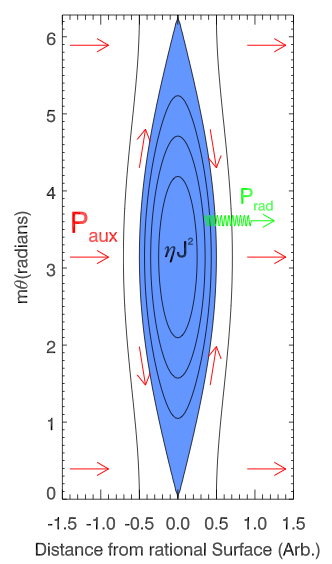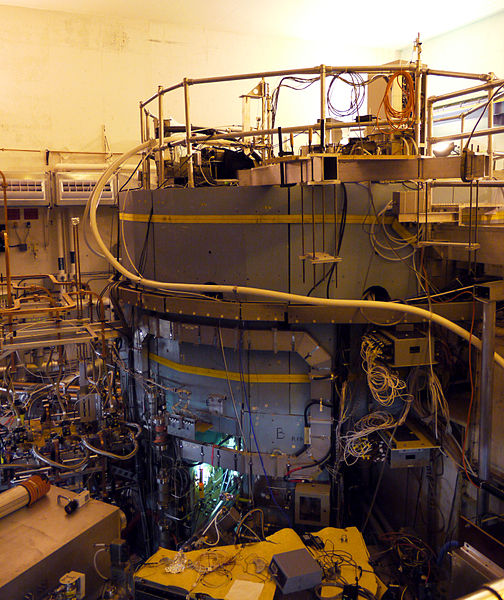A possible solution to a critical barrier to producing fusion energy
April 24, 2012

Representation of single lobe of a magnetic island schematically showing the heat flow from the auxiliary heating around the island (red arrows), the resistive heating inside the island (blue area), and the radiation losses from within the island interior (green arrow) (credit: D. A. Gates and L. Delgado-Aparicio/PPPL)
Princeton physicists have discovered a possible solution to a mystery that has long baffled researchers working to harness fusion as a source of power.
If confirmed by experiment, the finding could help scientists eliminate a major impediment to the development of fusion as a clean and abundant source of energy for producing electric power.
An in-depth analysis by scientists from the U.S. Department of Energy’s Princeton Plasma Physics Laboratory (PPPL) zeroed in on tiny, bubble-like islands that appear in the hot, charged gases — or plasmas — during experiments.
These minute islands collect impurities that cool the plasma. And it is these islands, the scientists report in the April 20 issue of Physical Review Letters, that are at the root of a long-standing problem known as the “density limit,” which can prevent fusion reactors from operating at maximum efficiency.
The mysterious density limit
Fusion occurs when plasmas become hot and dense enough for the atomic nuclei contained within the hot gas to combine and release energy. But when the plasmas in experimental reactors called tokamaks reach the mysterious density limit, they can spiral apart into a flash of light.
“The big mystery is why adding more heating power to the plasma doesn’t get you to higher density,” said David A. Gates, a principal research physicist at PPPL and co-author of the proposed solution with Luis Delgado-Aparicio, a post-doctoral fellow at PPPL and a visiting scientist at MIT’s Plasma Science Fusion Center.
“This is critical because density is the key parameter in reaching fusion and people have been puzzling about this for 30 or 40 years.”
The scientists hit upon their theory in what Gates called “a 10-minute ‘Aha!’ moment.” Working out equations on a whiteboard in Gates’ office, the physicists focused on the islands and the impurities that drive away energy. The impurities stem from particles that the plasma kicks up from the tokamak wall. “When you hit this magical density limit, the islands grow and coalesce and the plasma ends up in a disruption,” says Delgado-Aparacio.

The Alcator C-Mod tokamak experiment at the MIT Plasma Science and Fusion Center (credit: Wikimedia Commons)
These islands actually inflict double damage, the scientists said. Besides cooling the plasma, the islands act as shields that block out added power.
The balance tips when more power escapes from the islands than researchers can pump into the plasma through a process called ohmic (resistance) heating — the same process that heats a toaster when electricity passes through it.
When the islands grow large enough, the electric current that helps to heat and confine the plasma collapses, allowing the plasma to fly apart.
Testing the theory
Gates and Delgado-Aparicio now hope to test their theory with experiments on a tokamak called Alcator C-Mod at MIT, and on the DIII-D tokamak at General Atomics in San Diego. Among other things, they intend to see if injecting power directly into the islands will lead to higher density. If so, that could help future tokamaks reach the extreme density and 100-million-degree temperatures that fusion requires.
The scientists’ theory represents a fresh approach to the density limit, which also is known as the “Greenwald limit” after MIT physicist Martin Greenwald, who has derived an equation that describes it. Greenwald has another potential explanation of the source of the limit.
He thinks it may occur when turbulence creates fluctuations that cool the edge of the plasma and squeeze too much current into too little space in the core of the plasma, causing the current to become unstable and crash. “There is a fair amount of evidence for this,” he said. However, he added, “We don’t have a nice story with a beginning and end and we should always be open to new ideas.”
Conquering the limit could provide essential improvements for future tokamaks that will need to produce self-sustaining fusion reactions, or “burning plasmas,” to generate electric power. Such machines include proposed successors to ITER, a $20 billion experimental reactor that is being built in Cadarache, France, by the European Union, the United States and five other countries.
PPPL, in Plainsboro, N.J., is devoted both to creating new knowledge about the physics of plasmas — ultra-hot, charged gases — and to developing practical solutions for the creation of fusion energy. Through the process of fusion, which is constantly occurring in the sun and other stars, energy is created when the nuclei of two lightweight atoms, such as those of hydrogen, combine in plasma at very high temperatures. When this happens, a burst of energy is released, which can be used to generate electricity.
Ref.: D. A. Gates and L. Delgado-Aparicio, Origin of Tokamak Density Limit Scalings, Physical Review Letters, 2012 [DOI: 10.1103/PhysRevLett.108.165004]
Ref.: D. A. Gates and L. Delgado-Aparicio, On the Origin of Tokamak Density Limit Scalings, PPPL report 4278 [PDF] (open access)